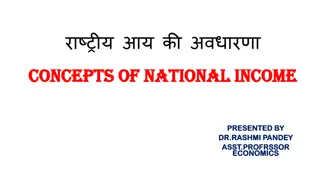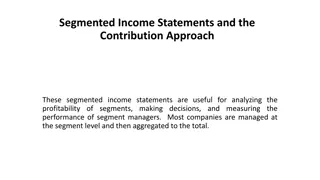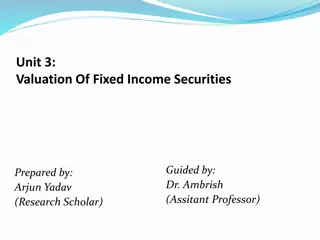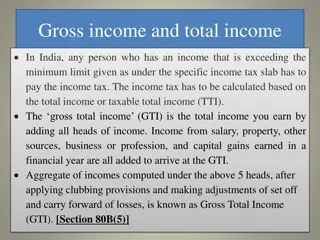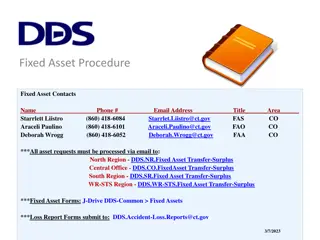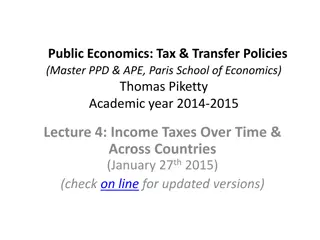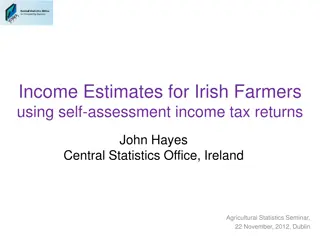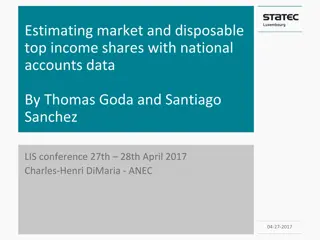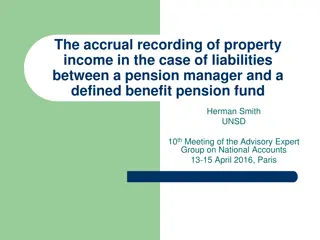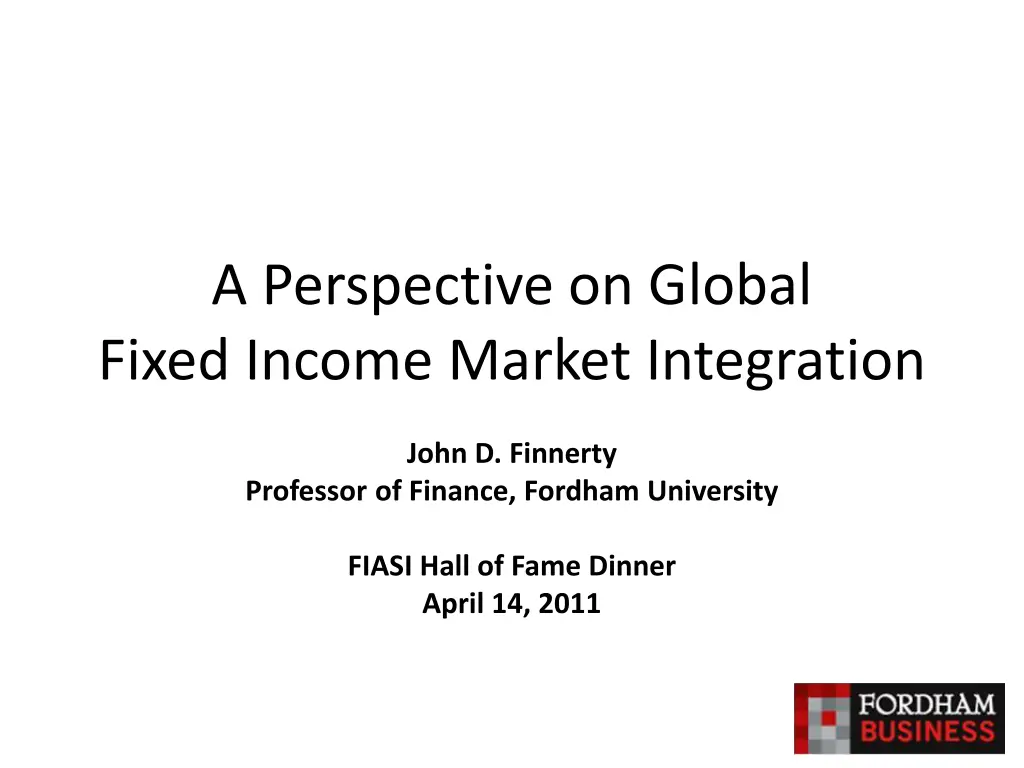
Global Fixed Income Market Integration Study
Explore the integration of global fixed income markets, focusing on ten well-developed countries over a 13-year period (1997-2009). Analysis includes term structure movements, key components, and factors influencing interest rates.
Download Presentation

Please find below an Image/Link to download the presentation.
The content on the website is provided AS IS for your information and personal use only. It may not be sold, licensed, or shared on other websites without obtaining consent from the author. If you encounter any issues during the download, it is possible that the publisher has removed the file from their server.
You are allowed to download the files provided on this website for personal or commercial use, subject to the condition that they are used lawfully. All files are the property of their respective owners.
The content on the website is provided AS IS for your information and personal use only. It may not be sold, licensed, or shared on other websites without obtaining consent from the author.
E N D
Presentation Transcript
A Perspective on Global Fixed Income Market Integration John D. Finnerty Professor of Finance, Fordham University FIASI Hall of Fame Dinner April 14, 2011
Overview The integration of the global equity markets has been studied extensively. The integration of the global fixed income markets, especially the emerging debt markets, has received less attention. We are studying the integration of the fixed income markets at Fordham Business School, and I want to share some interesting preliminary results with you. 2
Study Based on Ten Well-Developed Fixed Income Markets Australia Japan Canada Sweden France Switzerland Germany United Kingdom Italy United States 3
Data Daily price and yield data Range of sovereign debt issues that span the term structure (average of 26 issues per developed country, and 14 per emerging country) 13 years of data (1997-2009) Study daily movements in the term structure of interest rates Principal components analysis Study correlations of term structure movements across countries in the sample between 1997 and 2009 4
Four Key Components of Term Structure Movements Level (parallel shifts) Slope (steepening/flattening) Curvature (butterfly) Oscillation (chiefly monetary policy effects) 5
Analysis of Factors Responsible for Term Structure Movements Percentage of the Term Structure Movements in the Major Developed Countries Explained by the Four Term Structure Factors During Years 1997-2009 100.00% 90.00% 80.00% 70.00% 60.00% 50.00% 40.00% 30.00% 20.00% 10.00% 0.00% Australia Canada France Germany Italy Japan Sweden Switzerland United Kingdom United States Average Level Slope Curvature Oscillation Combined 6
Analysis of Factors Responsible for Term Structure Movements (Continued) Average Percentage of the Term Structure Movements in the Major Developed Countries Explained by the Level Factor During Years 1997-2009 100% 87.15% 90% 82.22% 79.72% 79.22% 78.00% 77.41% 76.98% 80% 76.20% 75.67% 70.94% 68.04% 70% 60% 50% 40% 30% 20% 10% 0% Australia Canada France Germany Italy Japan Sweden Switzerland United Kingdom United States Average 7
Analysis of Factors Responsible for Term Structure Movements (Continued) Average Percentage of the Term Structure Movements in the Major Developed Countries Explained by the Slope Factor During Years 1997-2009 18% 15.50% 16% 14% 12.67% 11.79% 11.45% 12% 11.39% 10.90% 10.86% 10.48% 10% 8.59% 8.55% 8% 7.33% 6% 4% 2% 0% Australia Canada France Germany Italy Japan Sweden Switzerland United Kingdom United States Average 8
Observations Concerning U.S. Term Structure Movements Percentage of the Term Structure Movements in the U.S. Explained by the Level Factor in 1997-2009 100% 95% 90% 85% 80% 75% 70% 65% 60% 55% 50% 1997 1998 1999 2000 2001 2002 2003 2004 2005 2006 2007 2008 2009 United States Other Developed Countries 9
Observations Concerning U.S. Term Structure Movements (Continued) Percentage of the Term Structure Movements in the U.S. Explained by the Slope Factor in 1997-2009 20% 18% 16% 14% 12% 10% 8% 6% 4% 2% 0% 1997 1998 1999 2000 2001 2002 2003 2004 2005 2006 2007 2008 2009 United States Other Developed Countries 10
Analysis of Underlying Economic Factors Term Structure Component Economic Factor Level Inflation Slope Economic Growth Curvature Economic Uncertainty Oscillation Variability of Monetary Policy 11
Analysis of Underlying Economic Factors (Continued) Average Percentage of the Term Structure Movements Explained by the Level ( 0) Factor vs. Average Annual GDP Deflator for the Major Developed Countries for 1997-2009 0.9000 4.0000 0.8500 3.0000 Average Percentage Explained by Level Factor Average Annual GDP Deflator (%) 0.8000 2.0000 0.7500 1.0000 0.7000 - 0.6500 (1.0000) 0.6000 (2.0000) United States Japan France Sweden Germany Switzerland United Kingdom Canada Australia Italy Average Percentage Explained by Level Factor Average Percentage Explained by Level Factor Average Annual GDP Deflator (%) 12
Analysis of Underlying Economic Factors (Continued) Average Percentage of the Term Structure Movements Explained by the Slope Factor vs. Standard Deviation of GDP Growth Rate for the Major Developed Countries for 1997-2009 0.18 3.0000 0.16 Average Percentage Explained by Slope Factor Standard Deviation of GDP Growth Rate (%) 2.5000 0.14 0.12 2.0000 0.10 0.08 1.5000 0.06 0.04 1.0000 0.02 0.00 0.5000 Italy Australia Switzerland United Kingdom Canada France Japan Germany Sweden United States Average Percentage Explained by Slope Factor Average Percentage Explained by Slope Factor Standard Deviation of GDP Growth Rate 13
Analysis of Underlying Economic Factors (Continued) Average Percentage of the Term Structure Movements Explained by the Curvature Factor vs. Average Consumer Confidence Indicator for the Major Developed Countries for 1997-2009 0.08 (94.00) 0.07 Average Consumer Confidence Indicator (Inverted) Average Percentage Explained by Curvature Factor (96.00) 0.06 (98.00) 0.05 (100.00) 0.04 (102.00) 0.03 (104.00) 0.02 (106.00) 0.01 0.00 (108.00) Italy Switzerland Canada AustraliaUnited StatesGermany Sweden FranceUnited KingdomJapan Average Percentage Explained by Curvature Factor Average Percentage Explained by Curvature Factor Average Consumer Confidence Indicator (Inverted) 14
Analysis of Underlying Economic Factors (Continued) Average Percentage of the Term Structure Movements Explained by the Oscillation Factor vs. Standard Deviation of the Annual Changes in Short-Term Interest Rates for the Major Developed Countries for 1997-2009 0.08 120% Standard Deviation of Annual Changes in Short-Term Interest Rates 0.07 Average Percentage Explained by Oscillation Factor 100% 0.06 80% 0.05 0.04 60% 0.03 40% 0.02 20% 0.01 0.00 0% Italy Australia Canada Germany United Kingdom Sweden Switzerland United States France Japan Average Percentage Explained by Oscillation Factor Average Percentage Explained by Oscillation Factor Standard Deviation of Annual Changes in Short-Term Interest Rates 15
Analysis of Correlations Among Term Structure Movements1 Significance of the Factor Correlations between the Major Developed Countries in Years 1997-2009 Level United Kingdom United States Australia Canada France Germany Italy Japan Sweden Switzerland Australia Canada France Germany Italy Japan Sweden Switzerland United Kingdom United States ----- 0% 0% 0% 0% 0% 0% 0% 0% ----- 0% 0% 0% 0% 0% 0% 0% ----- 0% 0% 0% 0% 0% 0% ----- 0% 0% 0% 0% 0% ----- 0% 0% 0% 0% ----- 0% 0% 0% ----- 0% 0% ----- 0% ----- ----- 0% 0% 0% 0% 0% 0% 0% 0% 0% Slope United Kingdom United States Australia Canada France Germany Italy Japan Sweden Switzerland Australia Canada France Germany Italy Japan Sweden Switzerland United Kingdom United States ----- 0% 0% 0% 0% 0% 0% 0% 0% ----- 0% 0% 0% 0% 0% 0% 0% ----- 0% 0% 0% 0% 0% 0% ----- 0% 0% 0% 0% 0% ----- 0% 0% 0% 0% ----- 0% 0% 9% ----- 0% 0% ----- 0% ----- ----- 0% 0% 0% 0% 0% 0% 0% 0% 0% Significant at the 1% level. Significant at the 5% level. Significant at the 10% level. 1 Based on extended Nelson-Siegel model. 16
Analysis of Correlations Among Term Structure Movements1 (Continued) Significance of the Factor Correlations between the Major Developed Countries in Years 1997-2009 Curvature United Kingdom United States Australia Canada France Germany Italy Japan Sweden Switzerland Australia Canada France Germany Italy Japan Sweden Switzerland United Kingdom United States ----- 72% 56% 0% 1% 26% 3% 61% 21% ----- 17% 38% 1% 14% 2% 0% 3% ----- 0% 18% 67% 0% 84% 12% ----- 3% 1% 0% 0% 23% ----- 7% 0% 56% 0% ----- 0% 0% 9% ----- 51% 44% ----- 38% ----- ----- 81% 0% 43% 71% 49% 10% 15% 77% 70% Oscillation United Kingdom United States Australia Canada France Germany Italy Japan Sweden Switzerland Australia Canada France Germany Italy Japan Sweden Switzerland United Kingdom United States ----- 0% 0% 32% 0% 79% 0% 0% 0% ----- 0% 50% 0% 19% 0% 0% 0% ----- 5% 0% 0% 0% 0% 0% ----- 8% 85% 46% 47% 32% ----- 6% 0% 0% 0% ----- 82% 6% 1% ----- 0% 0% ----- 0% ----- ----- 0% 0% 0% 12% 0% 0% 0% 0% 0% Significant at the 1% level. Significant at the 5% level. Significant at the 10% level. 1 Based on extended Nelson-Siegel model. 17
Observations Concerning Recent Correlations1 Significance of the Factor Correlations between the Major Developed Countries in Years 2006-2009 Level United Kingdom United States Australia Canada France Germany Italy Japan Sweden Switzerland Australia Canada France Germany Italy Japan Sweden Switzerland United Kingdom United States ----- 11% 0% 0% 0% 0% 0% 0% 23% ----- 0% 0% 0% 90% 22% 0% 0% ----- 0% 0% 0% 0% 0% 1% ----- 0% 0% 0% 0% 0% ----- 0% 0% 0% 0% ----- 0% 0% 0% ----- 0% 58% ----- 0% ----- ----- 0% 56% 0% 0% 20% 0% 0% 0% 1% Slope United Kingdom United States Australia Canada France Germany Italy Japan Sweden Switzerland Australia Canada France Germany Italy Japan Sweden Switzerland United Kingdom United States ----- 0% 0% 0% 0% 1% 0% 0% 0% ----- 0% 0% 0% 1% 0% 0% 0% ----- 0% 0% 0% 0% 0% 0% ----- 0% 0% 0% 0% 0% ----- 0% 0% 0% 0% ----- 0% 1% 0% ----- 0% 0% ----- 0% ----- ----- 0% 0% 0% 0% 0% 17% 0% 0% 0% Significant at the 1% level. Significant at the 5% level. Significant at the 10% level. 1 Based on extended Nelson-Siegel model. 18
Observations Concerning Recent Correlations1 (Continued) Significance of the Factor Correlations between the Major Developed Countries in Years 2006-2009 Curvature United Kingdom United States Australia Canada France Germany Italy Japan Sweden Switzerland Australia Canada France Germany Italy Japan Sweden Switzerland United Kingdom United States ----- 82% 86% 0% 0% 15% 50% 0% 20% 10% ----- 54% 92% 57% 71% 59% 24% 82% 2% ----- 0% 78% 15% 0% 48% 37% 68% ----- 1% 2% 3% 1% 6% 78% ----- 20% 0% 0% 97% 11% ----- 91% 14% 6% 13% ----- 0% 60% 0% ----- 25% 5% ----- 1% ----- Oscillation United Kingdom United States Australia Canada France Germany Italy Japan Sweden Switzerland Australia Canada France Germany Italy Japan Sweden Switzerland United Kingdom United States ----- 0% 0% 0% 0% 0% 0% 0% 0% 0% ----- 0% 0% 0% 0% 0% 0% 0% 0% ----- 0% 0% 0% 0% 0% 0% 0% ----- 0% 0% 0% 0% 0% 0% ----- 0% 0% 0% 0% 0% ----- 0% 0% 0% 0% ----- 0% 0% 0% ----- 0% 0% ----- 0% ----- Significant at the 1% level. Significant at the 5% level. Significant at the 10% level. 1 Based on extended Nelson-Siegel model. 19
What Role Does International Trade Play? 1997-2000 EU 2001-2005 EU 2006-2009 EU Country US Japan Other US Japan Other US Japan Other Australia 3 3 - - 4 4 2 - 2 3 1 3 Canada 4 4 1 - - 3 3 - 2 1 2 1 France 1 2 2 - 1 3 1 - - 4 2 - Germany - 3 - - 2 3 1 - 3 4 1 - Italy 1 2 1 - 2 4 1 - 3 4 - - Sweden 1 2 - - - 4 1 - 3 3 2 - United Kingdom 4 3 1 - - - 2 - 1 2 3 - Switzerland 1 2 1 - 2 4 2 - 2 3 3 - Japan 1 2 - 2 1 1 - 4 2 2 - 2 United States - 4 1 3 - - 2 2 - 3 3 2 20
Study Based on Seven Emerging Sovereign Debt Markets, 2006-2009 China Russia India South Africa Indonesia Turkey Mexico 21
Analysis of Factors Responsible for Term Structure Movements Percentage of the Term Structure Movements in the Emerging Sovereign Debt Markets Explained by the Four Term Structure Factors During Years 2006-2009 100% 90% 80% 70% 60% 50% 40% 30% 20% 10% 0% China Indonesia India Mexico Russia South Africa Turkey Average Level Slope Curvature Oscillation Combined 22
Comparison between Developed and Emerging Sovereign Debt Markets Comparison of the Factors Responsible for the Term Structure Movements Developed Countries vs. Emerging Countries, 2006-2009 100% Developed Emerging 90% 80% Developed Emerging 70% 60% 50% 40% 30% 20% Emerging Developed 10% Emerging Developed Emerging Developed 0% Level Slope Curvature Oscillation Combined (Diff = -0.40% ) (t-stat = -0.36 ) (Diff = 3.72% ) (t-stat = 0.62 ) (Diff = -0.73% ) (t-stat = -0.45 ) (Diff = -0.26% ) (t-stat = -0.22 ) (Diff = 2.33% ) (t-stat = 0.92 ) 23
Correlations between Developed and Emerging Sovereign Debt Markets1 Significance of the Factor Correlations between the Emerging Markets and US, Germany, Japan, and China in Years 2006-2009 Level Slope US Germany Japan China US Germany Japan China China 0% 0% 0%----- China 0% 0% 0%----- Indonesia 39% 0% 0% 0% Indonesia 2% 0% 0% 0% India 0% 0% 0% 0% India 3% 0% 0% 0% Mexico 28% 65% 0% 0% Mexico 0% 0% 0% 0% South Africa 0% 0% 0% 0% South Africa 0% 0% 0% 0% Turkey 99% 0% 0% 0% Turkey 0% 0% 0% 0% Curvature Oscillation US Germany Japan China US Germany Japan China China 51% 58% 0%----- China 0% 0% 0%----- Indonesia 67% 93% 78% 60% Indonesia 0% 0% 0% 0% India 88% 62% 8% 0% India 0% 0% 28% 0% Mexico 52% 37% 69% 66% Mexico 0% 0% 29% 0% South Africa 71% 44% 13% 34% South Africa 0% 0% 0% 0% Turkey 90% 60% 36% 0% Turkey 3% 49% 40% 0% Significant at the 1% level. 1 Based on extended Nelson-Siegel model. Significant at the 5% level. Significant at the 10% level. 24
What Role Does International Trade Play: Emerging Debt Markets? Number of Significant Correlations between Term Structure Factors in Years 2006-2009 Second Leading Trade Partner Third Leading Trade Partner Fourth Leading Trade Partner Fifth Leading Trade Partner Leading Trade Partner Germany Japan China 4 1 1 - 2 INC INC (USA) India - 1 2 1 3 INC 1 (China) (Singapore) Indonesia 1 1 - 1 1 1 INC (Japan) (China) Mexico - 1 3 - 2 INC - (Canada) (Germany) (China) South Africa - 1 - 2 3 INC INC (Japan) (UK) (China) Turkey - - 3 2 - INC - (China) 25
Conclusion Thank you for this wonderful award. Thank you for your attention. I look forward to seeing you at future FIASI events if I am invited to present additional results from this interesting research. 26

